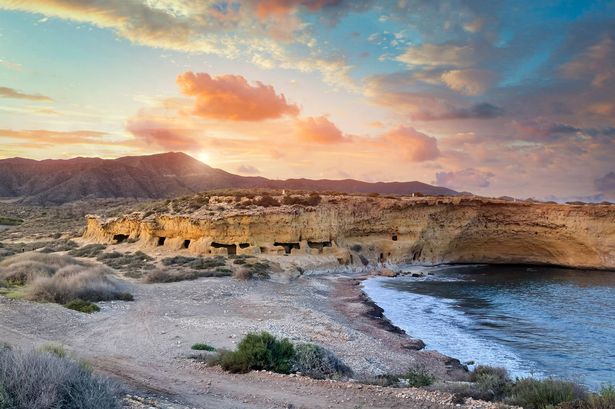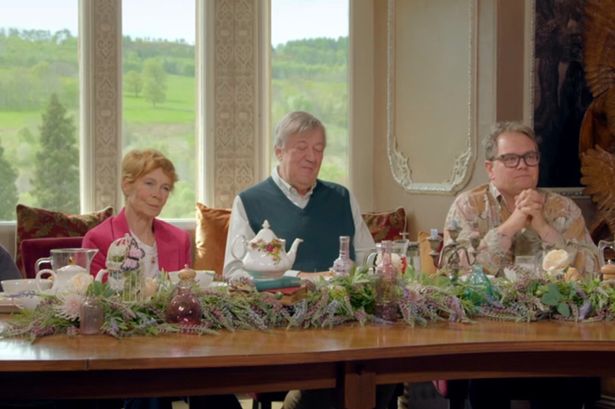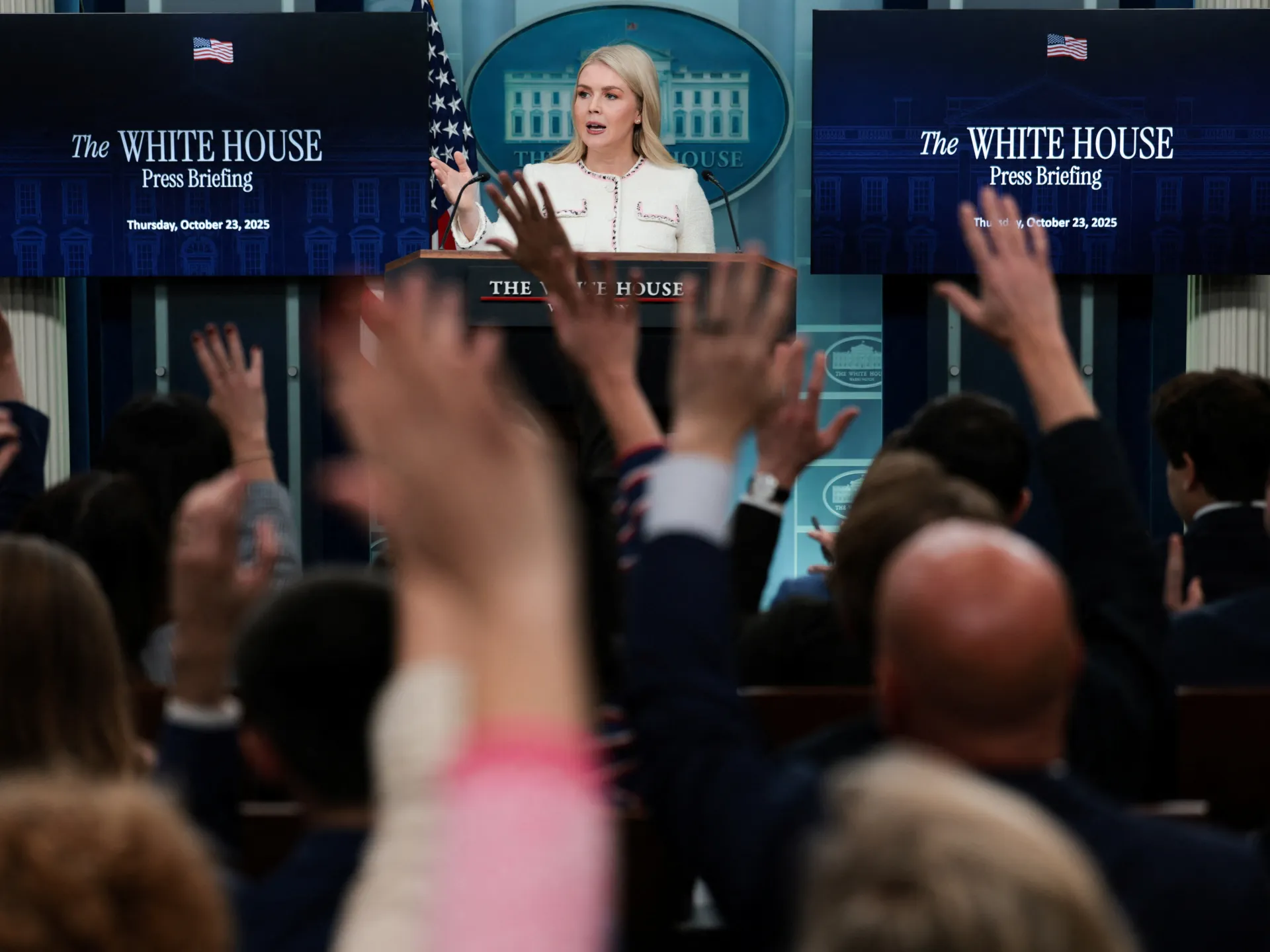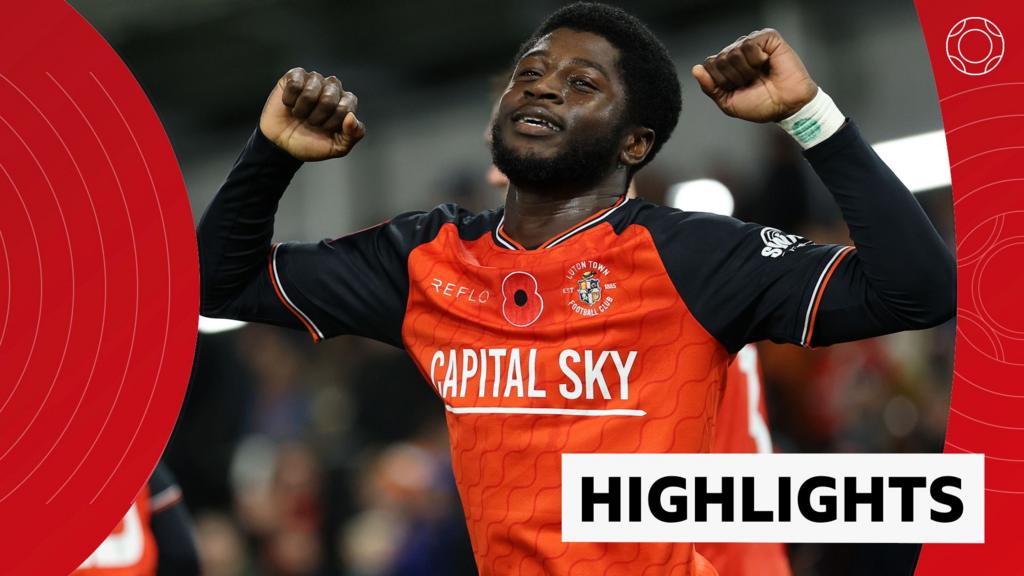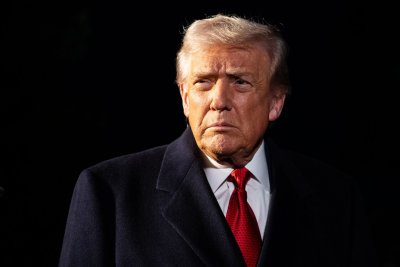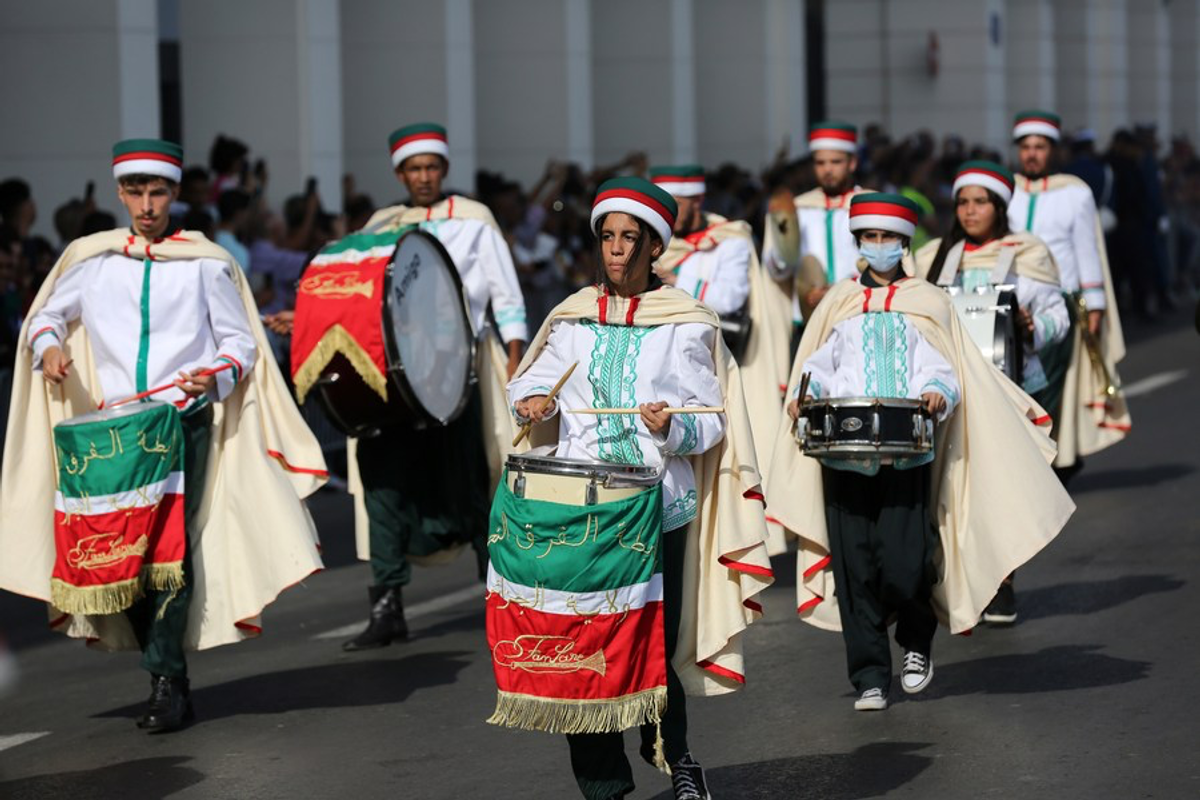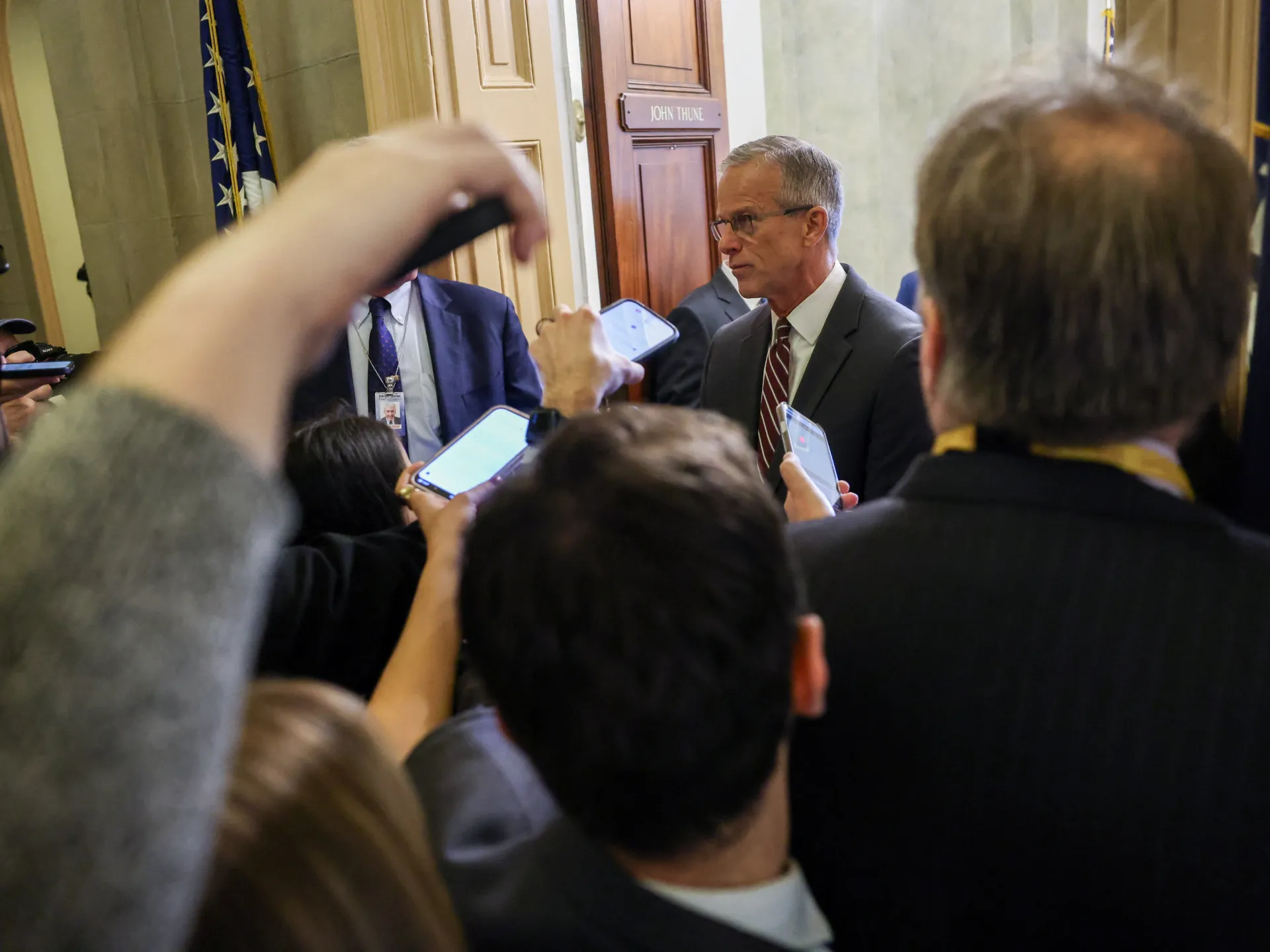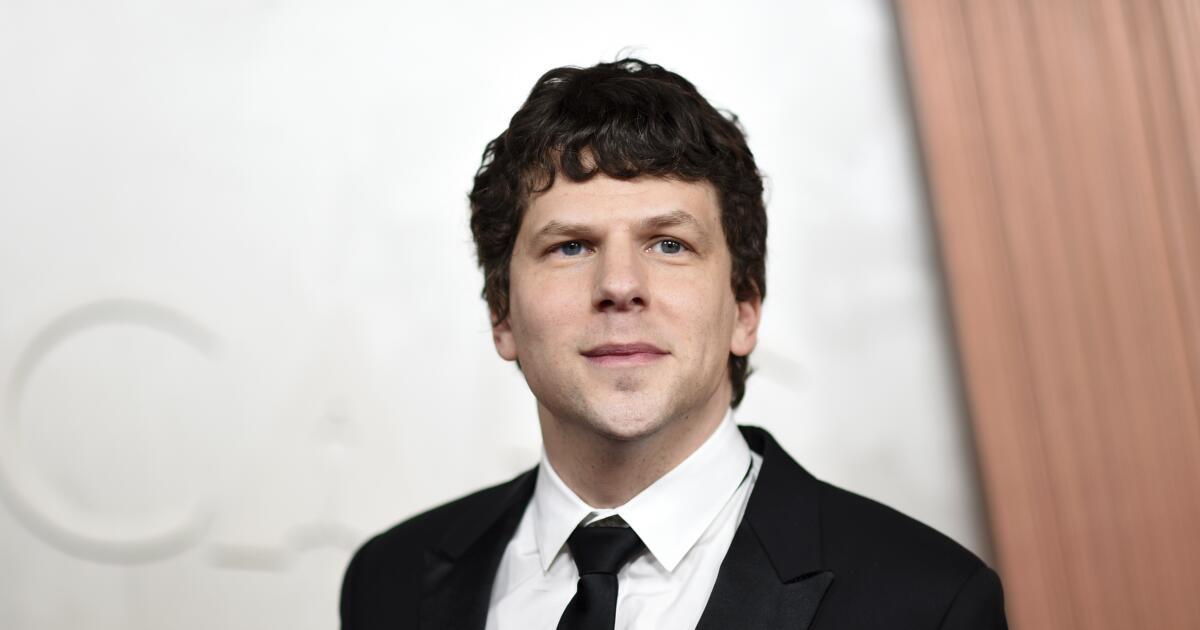New Ryanair route to destination that’s 21C in November
Flights start from £15
Ryanair is offering flights to a destination boasting November highs of 21C from just £14.99. The budget airline recently announced a 37% increase in its operations at Murcia airport for the upcoming winter, introducing four routes, including a new route to London Stansted with four weekly flights, and additional flights to Birmingham and Dublin.
Starting fares for flights to and from Murcia are as low as £14.99, and the expansion in connections will create over 450 local jobs and provide passengers with more choices at the lowest fares, according to Alejandra Ruiz, Ryanair’s spokesperson in Spain.
Ryanair’s schedule in Murcia for the 2025/2026 winter season continues to strengthen connectivity outside the peak season, creating over 450 local jobs and boosting year-round tourism in Murcia.
Despite Ryanair’s growth at Murcia Airport this winter season, the airline has been forced to cut one million seats from its overall schedule in Spain for the 2025/2026 winter season due to excessive increases in AENA charges (+6.62%) and ineffective ‘incentive schemes’, which are making regional airports financially unviable.
Ryanair has long championed and invested in regional airports, supporting access to low fares to stimulate tourism and employment, but it cannot justify continued investment in airports whose growth is hindered by uncompetitive charges.
Alejandra Ruiz, Ryanair’s spokesperson in Spain, announced: “Ryanair is pleased to announce its schedule for Murcia for the 2025 winter season, with four routes, including a new flight to London Stansted, with four weekly frequencies, as well as additional flights to Birmingham and Dublin.
“This new offering increases Ryanair’s capacity at Murcia Airport by 37%, giving our customers even more choice at the lowest fares.
“Despite excessive AENA charges, which have contributed to the loss of two million seats in 2025 in other regions, Ryanair remains committed to Murcia, where it operates year-round and supports over 450 local jobs.”
LAPD captain claims city pushed misleading protest tactic statement
It was April 2021 and the LAPD was facing sharp criticism over its handling of mass protests against police brutality. The Black Lives Matter-Los Angeles complaint accused officers of firing less-lethal weapons at demonstrators who posed no threat, among other abuses.
Smith said the assistant Los Angeles city attorney wanted his signature on a prewritten sworn declaration that described how LAPD officers had no choice but to use force against a volatile crowd hurling bottles and smoke bombs during a 2020 protest in Tujunga.
He refused to put his name on it.
Instead, eight months later, Smith filed his own lawsuit against the city, alleging he faced retaliation for trying to blow the whistle on a range of misconduct within the LAPD.
Los Angeles Police Department Capt. Johnny Smith.
(LAPD)
Smith and his attorneys declined to be interviewed by The Times, but evidence in his lawsuit offers a revealing look at the behind-the-scenes coordination — and friction — between LAPD officials and the city attorney’s office in defense of police use of force at protests.
Smith’s lawsuit says he felt pressured to give a misleading statement to cover up for reckless behavior by officers.
The captain’s claim, filed December 2021 in Los Angeles Superior Court, has taken on new significance with the city facing fresh litigation over LAPD crowd control tactics during recent protests against the Trump administration.
The 2020 protests led to a court order that limits how LAPD officers can use certain less-lethal weapons, including launchers that shoot hard-foam projectiles typically used to disable uncooperative suspects.
The city is still fighting to have those restrictions lifted, along with others put in place as a result of a separate lawsuit filed in June by press rights organizations.
Last month, City Atty. Heidi Feldstein Soto drew a rebuke from the City Council after she sought a temporary stay of the order issued by U.S. District Judge Hernán D. Vera.
Soto argued that the rules — which prohibit officers from targeting journalists and nonviolent protesters — are overly broad and impractical. Vera rejected Soto’s request, but the U.S. 9th Circuit Court of Appeals is taking up the matter, with a hearing tentatively set for mid-November.
A counterprotestor is arrested after approaching Trump supporters holding a rally in Tujunga in 2020.
(Kyle Grillot / AFP / via Getty Images)
Smith said in his lawsuit that he wouldn’t put his name on the Tujunga declaration because he had reviewed evidence that showed officers flouting LAPD rules on beanbag shotguns, as well as launchers that fire 37mm and 40mm projectiles — roughly the size of mini soda cans — at over 200 mph.
Smith’s lawsuit said the launchers are intended to be “target specific,” or fired at individuals who pose a threat — not to disperse a crowd.
Smith said he raised alarms for months after the Tujunga protest, which occurred amid outrage over the police killings nationwide of Black and Latino people at the end of President Trump’s first term.
But it wasn’t until the city got sued, Smith’s complaint said, that incidents he flagged started to receive attention.
The city has denied the allegations in Smith’s lawsuit, saying in court filings that each LAPD use of force case was thoroughly investigated.
Smith’s lawsuit cites emails to senior LAPD officials that he says show efforts to sanitize the department’s handling of excessive force complaints from the protests.
An internal task force deemed most of the citizen complaints “unfounded.” Yet nearly two dozen of those cases were later reopened after Smith and a small team of officers found that the department’s review missed a litany of policy violations, his lawsuit says.
Smith also called out what he saw as “problematic bias” in the way what occurred at the Tujunga protest was reported up the chain of command.
His complaint describes a presentation given to then-Chief Michel Moore that downplayed the severity of the damage caused by less-lethal projectiles. According to Smith, the report omitted photos of “extensive injuries” suffered by one woman, who said in a lawsuit that she had to undergo plastic surgery after getting shot in the chest at close range with a beanbag round.
The LAPD stopped using bean-bag shotguns at protests after a state law banned the practice, but the department still allows officers to use the weapons in other situations, such as when subduing an uncooperative suspect.
Los Angeles police officers attempt to stop a confrontation between Trump supporters and counterprotestors during a pro-Trump rally in Tujunga in 2020.
(Kyle Grillot / AFP / via Getty Images)
Alan Skobin, a former police commissioner and a friend of Smith’s, told The Times he was in the room when Smith received a call in April 2021 from the city attorney’s office about the declaration he refused to sign.
The exchange appeared to turn tense, Skobin recalled, as Smith repeated that details contained in the document were a “lie.”
Skobin said he wondered whether the assistant city attorney went “back and examined the videotaped and all the other evidence.”
“That’s what I would hope would happen,” Skobin said.
A spokesperson for the Los Angeles city attorney, Karen Richardson, provided The Times with a California State Bar report that said there was insufficient evidence to discipline the lawyer involved; the case was closed in June 2024.
Richardson declined further comment, citing Smith’s pending lawsuit.
According to Smith, other high-ranking LAPD officials went along with the misleading story that the officers in Tujunga acted in response to being overwhelmed by a hostile crowd.
Smith claims he faced retaliation for reporting a fellow captain who said police were justified in using force against a protester who held a placard turned sideways “so that the pole can be used as a weapon against officers.”
Body camera footage showed a different version of events, Smith said, with officers launching an unjustified assault on the man and others around him.
The colleague that Smith reported, German Hurtado, has since been promoted to deputy chief.
The city has denied the allegations in court filings. When reached for comment on Friday, Hurtado said he was limited in what he could say because the litigation is ongoing.
“From what I understand all that’s been investigated and it was unfounded,” he said, referencing Smith’s allegations.
“The lawsuit, I don’t know where it’s and I don’t know anything about it. No one’s talked to me. No one’s deposed me.”
Critics argue that the LAPD continues to violate rules that prohibit targeting journalists during demonstrations.
After a peaceful daytime “No Kings Day” protest downtown Oct. 18, about 100 to 200 people lingered outside downtown’s Metropolitan Detention Center after nightfall. Police declared an unlawful assembly and officers began firing 40mm projectiles.
Lexis-Olivier Ray, a reporter for the news site L.A. Taco who regularly covers demonstrations, was among those hit by the rounds.
Hundreds participate in the No Kings Day of Peaceful Action in downtown Los Angeles on Oct. 18.
(Genaro Molina / Los Angeles Times)
In a video shared widely online, an LAPD officer can be heard justifying the incident by saying they were firing at “fake” journalists.
An LAPD spokesperson said the incident with Ray is under internal investigation and could offer no further comment.
Ray said it wasn’t the first time he’d been struck by less-lethal rounds at protests despite years of legislation and court orders.
“It’s pretty discouraging that stuff like this keeps happening,” he said.
Jim McDonnell was introduced by Mayor Karen Bass to serve as LAPD chief during a news conference at City Hall on Oct. 4, 2024.
(Ringo Chiu / For The Times)
LAPD Chief Jim McDonnell defended the department at the Police Commission’s weekly meeting Tuesday, saying the “No Kings” protesters who remained downtown after dark were shining lasers at officers, and throwing rocks, bottles and fireworks.
Asked about the incident involving Ray, the chief said he didn’t want to comment about it publicly, but would do so “offline” — drawing jeers from some in the audience who demanded an explanation.
McDonnell told the commission that he supported the city’s efforts to lift the court’s injunction. Easing the restrictions, he said, would “allow our officers to have access to less-lethal force options so that we don’t have to escalate beyond that.”
Times staff writer Noah Goldberg contributed to this report.
Football gossip: Guehi, Jackson, Santos, Bouaddi, Saibari
Inter Milan join race for defender Marc Guehi, Everton monitoring striker Nicolas Jackson, and Manchester United face competition for Ayyoub Bouaddi.
Inter Milan want to sign England centre-back Marc Guehi, 25, when his Crystal Palace contract expires next summer, but face competition from Barcelona, Bayern Munich, Real Madrid and Liverpool. (Gazzetta dello Sport – in Italian), external
Everton are monitoring Senegal striker Nicolas Jackson, 24, as Bayern Munich are increasingly unlikely to trigger a £70m move for the on-loan Chelsea forward. (Football Insider), external
Manchester United are keen on Chelsea’s Brazil midfielder Andrey Santos, 21, as they bid to strengthen their midfield in January. (Football Insider), external
Manager Ruben Amorim expects some of his Manchester United squad to ask to leave in January in search of more minutes. (Times – subscription required), external
Manchester United have had internal discussions over signing Lille’s French midfielder Ayyoub Bouaddi, 18. (Caught Offside), external
Arsenal and Liverpool are also in the mix to sign talented teenager Bouaddi. (TBR Football), external
Bournemouth and Ghana winger Antoine Semenyo, 25, says he is not oblivious to speculation around his future, but glad he remained with the Cherries in the summer. (Sky Sports), external
PSV Eindhoven’s Ismael Saibari is emerging as a January target for a host of Premier League clubs, with Aston Villa and Leeds among those interested in the 24-year-old Morocco midfielder. (TBR Football), external
Real Madrid have joined Manchester United and Chelsea in tracking Red Bull Salzburg’s Bosnia-Herzegovina winger Kerim Alajbegovic, 18. (Defensa Central – in Spanish), external
Ohio approves redistricting map that might add more GOP seats

Oct. 31 (UPI) — Ohio’s representatives approved a bi-partisan redistricting map that might help Republicans gain more seats, but Democrats OK’d the plan because the others offered were worse for them.
The Ohio Redistricting Commission approved the measure unanimously Friday.
“Coming to an agreement that is in the best interest of the state, not just the most vocal elements of either party, I think is some of the toughest things that we can do as elected leaders in 2025,” said state Rep. Brian Stewart, R-Ashville, the Columbus Dispatch reported.
But Senate Minority Leader Nickie Antonio said it was the best option among bad ones.
“Facing this impossible challenge with no certain path to preserve a fair map, we worked toward compromise,” said Antonio, D-Lakewood.
Democrats faced a Friday deadline because the Ohio constitution allows Republicans to create a map without Democrats in November. They were also concerned about a case before the U.S. Supreme Court on the Voting Rights Act.
Democratic Rep. Emilia Sykes of Akron will get a slightly more favorable northeast Ohio district, but it will still be very competitive, Punchbowl News reported.
Toledo Rep. Marcy Kaptur‘s district will be more difficult to win, but not impossible. She’s the longest-serving representative in the United States, and she won a close race in 2024. Her district chose President Donald Trump by seven points.
“Let the Columbus politicians make their self-serving maps and play musical chairs, I will fight on for the people and ask the voters for their support next year,” she wrote on X.
Cincinnati Rep. Greg Landsman also saw his chances at re-election diminished.
Ohio House Minority Leader Dani Isaacsohn, D-Cincinnati, said all of Ohio’s Democratic congresspeople could still win.
“This is a district Greg Landsman can and will win in, and that’s what the people of Cincinnati deserve,” Isaacsohn said.
Ohio had a failed ballot measure in 2024 that would have put residents in charge of making district maps.
“There’s a lot of anger and frustration in this room, and it’s not just the result of this most recent betrayal. The anger and frustration has been years in the making,” said Mia Lewis, associate director at Common Cause Ohio, the Dispatch reported.
“You have shown all of us, all of Ohio, that politicians cannot be involved in drawing district lines.”
Jen Miller, executive director of the League of Women Voters of Ohio, said the people were denied being part of the process. “Republican and Democratic voters feel like their parties sold them out — and they’re both right.”
I won’t let war stop me visiting Ukraine – I’ve watched rockets fall above my head
British blogger Kieren Adam Owen, better known as JimmyTheGiant, has become a passionate defender of Ukraine since marrying Vlada after meeting her on a holiday in Thailand
“The first thing you notice about Ukraine is how spotless the toilets are.”
British blogger Kieren Adam Owen, better known as JimmyTheGiant, was taken aback by the sparkling state of the bathrooms in Lviv when he visited the Ukrainian city for the first time after meeting his now-wife, Vlada, whom he had fallen head over heels for during a holiday in Thailand.
But it’s not just the immaculate nature of the WCs that caught Keiren’s eye. He is now a great enthusiast for the food, the coffee, the community life in the countryside and much else in Ukraine.
He is not the only one to have fallen for a nation that has been devastated by the war, or who is willing to go to great lengths to get there. According to data compiled by the State Border Service of Ukraine and VisitKyiv.com for the first half of 2025, foreigners crossed the Ukrainian border 1,194,983 times – 6,000 more than in the same period last year. That is, of course, a much smaller number than before the war and the coronavirus pandemic. In 2019, 13.4million tourists visited Ukraine.
All those who do go are risking their lives to varying degrees. As of 30 September 2025, 14,383 civilians had been killed in the war, according to the OHCHR. The UK Foreign Office states bluntly that it “advises against all travel to parts of Ukraine.”
Kieren is clearly aware of these dangers and not immune to fear. When in the country, whenever the air raid sirens begin to ring out, he immediately rushes down to the shelter: unlike some war-weary Ukrainians. “I can imagine that when you live there, you don’t always want to go to a shelter — probably because it’s a headache, and you know that the actual attacks that hit are fewer than the ones you hear the sirens for. But when you’re traveling, you can kind of do it, so I always just go to the shelter whenever,” he told the Mirror.
READ MORE: UK’s ‘most magical street’ is real-life Diagon Alley with quirky shops and hidden gemsREAD MORE: The UK’s ‘most remote village’ where people get stranded in its ‘perfect pub’
While most today are travelling for work or family events, some head to the war-torn country simply to explore. Others are on pilgrimage to Uman – an annual trip when thousands of Hasidim visit the tomb of Rabbi Nachman, founder of Bratslav Hasidism. Humanitarian trips are common, with large numbers travelling to participate in dozens of reconstruction projects crucial for a country that has been battered by missiles and drone strikes since February 2022.
Surprisingly, it is not in the cities that Keiren has felt most scared. Rather, it is in the rural areas without bomb shelters where he’s most feared for his life. There, he has watched rockets falling right above his head, with nowhere to hide except the house he was living in. “You feel more vulnerable there — there’s only ‘God’s protection’,” he said.
Kieren was once best known for his analytical takes on economics and politics, before he began producing documentary reports from Ukraine. The change in direction came after he married Vlada.
Now he spends a significant portion of his time promoting the lesser-known aspects of one of Europe’s poorest countries.
In a 52-minute YouTube video titled ‘How Ukraine changed my life‘, which he published earlier this year, the Milton Keynes lad explained how the country stole his heart.
“Your image of Ukraine is of this very brutalist, post-Soviet, kind of depressing, poor place, and Lviv just shattered this mental image. You’re walking on these cobbled streets, and you see all these beautiful, stunning, classical buildings. Everyone around you is cooler than you, dressed cooler than you, they’re just stylish, chill bras. Every single restaurant or cafe is on the level of the coolest of cool places in London, even better in some cases. The coffee… I literally became a coffee snob because of that trip.”
Keiren’s adulation for Ukraine stretches to the rural areas, where his in-laws live. There, wages are much lower than in Lviv and the capital Kyiv, yet access to great stretches of arable countryside abounds. Many work the land alongside their day jobs, building up larders with conserves and wines, as small-holding, subsistence farmers.
“I would argue in some regards, they live a much more fulfilling life than many poor people in the UK,” Kieren says in his video, noting the level of community cohesion, access to nature and fresh food many rural Ukrainians enjoy.
Kieren makes clear that he “isn’t saying that their lives are heaven” or that serious poverty, access issues for disabled people, and low life expectancy aren’t serious issues in the country.
Kieren has never been close to the front line, where the level of danger is much higher. Despite the risks he runs by being in Ukraine, he is keen to keep returning to a country he has fallen in love with.
“This is how high-quality everything is. I miss how everywhere you go, everything just feels perfect. That’s super nice. And the vibe. It’s just nice to be in Ukraine — the trees, the streets of Kyiv, the people who, despite the war, remain friendly and create an incredible atmosphere,” he continued.
For many Brits who find a second home abroad, the financial clout of the pound is a significant benefit. As he earns money in Britain, Kieren can afford more than he would back in the UK.
“When you come here, you feel like a millionaire,” he joked. “So you can have a really enjoyable week, constantly visiting various establishments.”
Kieren’s top recommendation is the restaurant 100 rokiv tomu vpered (100 Years Ahead), run by renowned Ukrainian chef Yevgen Klopotenko, who serves up traditional dishes, such as borscht, and the less typical fried bees. Another favourite place is Musafir, a Crimean Tatar restaurant known for its fried, doughy chibereks.
When not indulging in the local fare, Keiren enjoys spending time on Reitarska Street, an artistic hub in Kyiv, and Andriivskyi Uzviz. Kieren also recommends visiting the Golden Gate in the city center, a historic structure that was once the entrance to Kyiv, as well as having a picnic in one of Kyiv’s parks, such as Taras Shevchenko Park.
The top 10 countries by number of entries into Ukraine in the first half of 2025
- Moldova — 509,219
- Romania — 197,012
- Poland — 116,589
- Hungary — 60,400
- Slovakia — 35,279
- Israel — 26,869
- Germany — 23,687
- Turkey — 22,858
- United States — 22,840
- United Kingdom — 17,210
South-South Cooperation in Action: The China-Egypt Partnership
Relations between Egypt and China have proven their ability to keep pace with international and regional transformations. China is one of Egypt’s major trading partners, with annual trade volume exceeding billions of dollars. Recent years have witnessed an increase in Chinese investments in Egypt, particularly in the fields of infrastructure, industry, and energy, with a focus on mega-projects such as the New Administrative Capital and the Economic and Trade Cooperation Zone in the Suez Canal Corridor, among others. The two countries also pursue compatible policies in terms of working for peace throughout the world and advocating for the establishment of a multipolar system.
We find that Chinese investments in Egypt play a significant role in many areas, most notably technology transfer to Egypt, particularly in sectors where China excels, such as renewable energy, the electric car industry, and all types of appliances. Chinese investments in Egypt also provide significant job opportunities and help Egypt implement its import substitution strategy by producing more products that help reduce Egypt’s import bill with Chinese assistance and support. As of May 2025, the number of Chinese companies operating in Egypt reached approximately 2,800, with total investments exceeding $8 billion. These Chinese investments are characterized by their diversity and geographical spread in Egypt, from the Suez Canal to the New Administrative Capital. Cooperation between Egypt and China has extended to the fields of technology and artificial intelligence, with Chinese companies present in the Egyptian market, such as Huawei, Xiaomi, and ZTE. A $300 million investment fund has been established with the Tsinghua University of Artificial Intelligence and Semiconductor Technology, in addition to fiber optics and outsourcing projects.
Chinese projects contribute significantly to Egypt’s domestic growth by attracting billions of dollars in Chinese investments in various sectors, such as industry, construction, and infrastructure, along with technology transfer and industrial localization. Chinese companies in Egypt are also working to establish industrial complexes and develop mega projects, such as the iconic tower in the New Administrative Capital, and establish industrial zones in the Suez Canal and Ain Sokhna regions, contributing to job creation and added value for the Egyptian economy. Chinese development projects also contribute to the development of energy and electricity infrastructure, the training of Egyptian personnel, and the export of products to African and European markets. The win-win principle that governs the Chinese model of international dealings is a principle that suits Egypt, its leadership, and its people.
The most prominent contributions of Chinese projects to Egypt’s domestic growth are attracting Chinese investments to Egypt, which amount to billions of dollars. China also contributes to localizing industries and transferring technology to Egypt, where technology and knowledge are transferred from China to Egypt, in addition to establishing Chinese factories to produce various products, such as automobiles, steel, textiles, and others. China also plays a significant role in developing Egypt’s infrastructure, with Chinese companies contributing to the construction of major infrastructure projects, such as the development of power plants and the expansion of their distribution networks, as well as the construction of modern roads and towers. Chinese projects in Cairo thus create job opportunities and provide significant export opportunities, as these Chinese projects provide thousands of job opportunities for Egyptian workers. Egypt is a strategic gateway for China to export its products to Africa and Europe, thanks to its distinguished strategic geographic location. In addition, China plays a significant role in developing Egypt’s economic sectors, as these Chinese projects focus on vital sectors such as industry, construction, tourism, advanced technology, and manufacturing, which supports overall economic growth in Egypt. This enhances Egypt’s benefits from China’s Belt and Road Initiative, as Egypt’s accession to the Belt and Road Initiative enhances economic cooperation with China and facilitates the flow of Chinese investments into Egypt.
Chinese investments in Egypt received a significant boost under President “Abdel Fattah El-Sisi”. Egypt became an active member of China’s Belt and Road Initiative, and Egypt joined the BRICS bloc and the New Development Bank. Chinese projects have subsequently become important, yielding positive returns and impacting Egyptian citizens. The most prominent of these are major Chinese projects in Cairo, such as the financial and business district in the New Administrative Capital, the electric train, renewable energy projects, and textile factories, among others. These are all Chinese projects that Egyptian citizens are already aware of and following. These Chinese investments in Egypt create new job opportunities and open the door for Chinese products to enter African and Arab markets, benefiting both sides.
Egyptian-Chinese cooperation is an ideal model for cooperation between the Global South, and Southern issues have been a major focus of the political leadership of both Egypt and China. Chinese and Egyptian Presidents Xi Jinping and Abdel Fattah El-Sisi have repeatedly emphasized the importance of solidarity among the countries of the South to confront common challenges. Egypt’s accession to the BRICS grouping, and previously to the Shanghai Cooperation Organization, as a partner country reflects its commitment to expressing the views of the countries of the South and promoting their interests. Meanwhile, China has presented its own vision on the issues of the South, evident in the numerous initiatives and ideas it has put forward, including the Belt and Road Initiative, the Global Development Initiative, and Global Governance, all of which are closely linked to the development goals of the countries of the South. This is also reflected in the vision of Chinese President Xi Jinping for “building a community with a shared future for humanity.”
China’s cooperation with Egypt reflects a new Chinese vision for South-South cooperation, based on equality and non-interference. It reflects Beijing’s commitment to advancing cooperation toward strategic horizons that transcend traditional interests and build alliances capable of influencing the future of the international system. Egypt’s strong support and backing of President “Abdel Fattah El-Sisi” for the Global Governance Initiative launched by Chinese President “Xi Jinping” in early September 2025, with the aim of enhancing joint global cooperation to increase capacity to address common challenges and narrow the development gap between the countries of the North and the South, complements China’s and Egypt’s categorical rejection of the (Cold War mentality, protectionism, unipolarity, and hegemonic policies) pursued by the United States toward the world.
China’s massive military parade marking the 80th anniversary of the end of World War II demonstrated Egypt’s strong support for China’s strength and its determination to maintain peace and development in the world. The 2025 Shanghai Cooperation Organization (SCO) Summit, held in Tianjin, China, also highlighted the strong political will of China and its ruling Communist Party to contribute to reforming and improving the global governance system. The Tianjin Summit is the largest, most fruitful, and most successful summit in the history of the SCO to date. Through it, China and President “Xi Jinping” championed the principles of global governance, adhering to mutual benefit and win-win outcomes, openness and inclusiveness, justice and fairness, and pragmatism and efficiency in order to achieve justice and advance policies of cooperation among developing countries of the Global South in the face of American and Western hegemonic policies.
This year marks the 80th anniversary of the founding of the United Nations, a matter of particular interest to political circles in Egypt and China, as they play an increasing role in maintaining world peace and promoting international justice. In this context, Egypt and China have achieved fruitful results in comprehensive cooperation and advancing cooperation within the developing global South. Currently, the Egyptian and Chinese sides are working jointly to advance and ensure the success of China’s Global Governance Initiative, which will deliver tangible benefits to the two peoples and to the peoples of the region. This will make Sino-Egyptian relations a model for building a “community of shared destiny, mutual benefit, and shared prosperity,” in accordance with the vision of Chinese President Xi Jinping.
Accordingly, we understand that the Chinese partnership with Egypt embodies the principles of global governance. The convergence between China’s Belt and Road Initiative and Egypt’s Vision 2030 enhances opportunities for development cooperation between the two parties and confirms the two countries’ commitment to dialogue and consultation and the rejection of hegemony and interference, in line with the principles of global governance. This, in particular, reinforces the principle of the rule of international law within the United Nations and in all international forums in order to support developing countries of the Global South, far removed from the policies of exclusion, hegemony, and the Cold War mentality that Washington currently pursues in its dealings with the world.
Celebrity Traitors star Alan Carr tipped to become new host of Strictly Come Dancing
Comedian Alan Carr has quickly become an unlikely favourite to win Celebrity Traitors, which draws to a close BBC One on Thursday, and his popularity has rocketed
Alan Carr — teasing millions of The Celebrity Traitors viewers — has been tipped to become a new presenter of Strictly Come Dancing.
The comedian, 49, is vying to win the reality TV series, which draws to a close on Thursday night on BBC One. PR experts say his stint on the programme, a spin-off from the civilians’ version, has helped further boost Alan’s popularity, following previous success with his own titular show on Channel 4.
And now the broadcaster is being touted to step in to host Strictly Come Dancing next year, following the departures of Claudia Winkleman and Tess Daly. One insider said: “More people are watching Alan than are watching Strictly right now. He’s been catapulted to the A-list. The star dust is practically dripping off him.”
READ MORE: Kate Garraway reveals which Celebrity Traitors star has snubbed WhatsApp groupREAD MORE: Dani Dyer says ‘I feel embarrassed’ as she shares Strictly Come Dancing heartbreak
It is said Alan, the son of a former professional footballer, thought he would have been the first kicked off The Celebrity Traitors, but he has survived to reach the final five contestants. His antics alongside the likes of Sir Stephen Fry, Kate Garraway, Clare Balding and Celia Imrie have had millions of Brits hooked since October 8.
Alan, who won a BAFTA for Alan Carr: Chatty Man in 2013, was praised for displaying his “super competitive streak” and charisma, traits insiders believe make him an ideal match for Strictly. A source told the Daily Mail: “He’s an old-fashioned showbiz pro who would be just perfect hosting Strictly. If he does manage to win Traitors it will be a sign to the BBC that he has the star quality to present its flagship show.”
The search is on to replace Claudia and Tess, who have both been associated with Strictly and its spin-off programmes for more than 20 years. Former Strictly performer, Vincent Simone, had said the hosts need to be replaced by “familiar faces that the audience already trusts”.
He said: “It’s hard to predict. I think the BBC should go for people who are already well-known and experienced – not newcomers. Familiar faces that the audience already trusts, like Paddy McGuinness or even Noel Edmonds. If you bring in big names the public already loves, they’ll go along with the change more easily.”
Alan, a comedian for nearly three decades, has been ruthless throughout his time on The Celebrity Traitors, dispatching his close friend Paloma Faith, and similarly, actress Celia Imrie on Thursday night. The source continued: “His public persona is one of being a bit of a giggle, a bit of a pushover, but that is definitely not the case at all.”
After graduating from university, Alan moved to Manchester, with his sights on a career in comedy. He worked in a call centre for five years, while treading the boards in his spare time on the stand-up comedy circuit, winning awards and a huge following along the way.
Boy, 13, denied boarding Qatar Airways flight for Thailand trip over passport issue
Meghan Law, who is an NHS nurse, has expressed her anger after her teenage son Alix Dawson was not allowed to board the Qatar Airways plane for Phuket, Thailand
A mum has blasted Qatar Airways after her 13-year-old son was denied boarding their flight for Thailand.
Meghan Law said there was “no justification” for her experience at Edinburgh Airport, which threatened to derail her £3,000 family holiday. Check-in staff, though, told Meghan there was a “luggage sticker mark” on Alix Dawson’s passport, which they said constituted “damage”.
The mum was ordered to go to Glasgow Airport — around 50 miles away — for a new emergency document. Scrambling to salvage her family’s holiday, Meghan contacted TUI, who she had booked the trip with, for their advice. The tour operator found no issues with the passport and put them on the next available flight to Thailand.
But Meghan, 33, has now vowed to never use Qatar Airways again. The NHS nurse, who has two kids, said: “If I hadn’t booked through TUI and booked it myself, we just wouldn’t have been able to go on holiday. One way from Glasgow on the same day of travel would’ve been £2,800. There’s no way I would’ve been able to pay that.
“I’d never had an experience like that at any other airport. There was no justification for it. I’ll never fly with Qatar again. It ruined the start of the trip – it was so stressful.”
READ MORE: Foreign Office travel insurance warning to anyone going to Italy in early 2026READ MORE: Hurricane Melissa honeymoon couple and TikToker slammed for ‘complaining’
Meghan, who lives in Aberdeen, has now returned from her two-week holiday, but wants to raise awareness of her experience. HM Passport Office classes a passport as damaged for several reasons, including if details are indecipherable, if there are missing or detached pages and if there is a chemical or ink spillage on any page.
But Meghan said Alix’s document had neither of these issues, and had previously been accepted dozens of times at airports. She continued: “I said I’ve used this umpteen times. No one’s ever mentioned any damage on it before. There were no rips or stains, I don’t know what she was trying to imply. I was really shocked.
“She told me that I need to get an emergency passport from Glasgow Airport. Then she said actually it’s not your passport that’s the problem, it’s your child’s, Alix.
“What they were trying to say was that the luggage check-in stickers that had been stuck on one of the pages [and] had damaged the page. But it wasn’t even on the photo page.
“There were no rips, it was just where the sticker marks had been. They said we couldn’t travel with it. I knew there were no issues with their passports. We’d probably travelled over a dozen times with those passports. We were just left in the airport with no help and no advice.”
The Mirror has contacted Qatar Airways for comment.
Favorite Ted Noffey wins $2 million Breeders’ Cup Juvenile
DEL MAR — Sometimes the toughest part of owning a horse is deciding what to name it. If you own a bunch of horses, you run out of logical names pretty quickly. You can only do a play on the sire’s name so many times. And if you name it after a living person, you need permission from that person.
But every once in a while happenstance is your guide.
Ned Toffey has been the general manager of Spendthrift Farm for 21 years. Spendthrift saw an Into Mischief colt it liked and bought the yet unnamed colt as a yearling for $650,000. Now the tough part, naming him.
Toffey had just completed an interview with a publication and it was trying to promote it on social media. The only problem is they got a couple of first letters transposed and sent out posted a message on X calling the longtime Spendthrift executive Ted Noffey. Innocent mistake. Once notified it was corrected but not before a few screenshots were taken.
John Velazquez smiles after riding Ted Noffey to victory in the Breeders’ Cup Juvenile horse race in Del Mar on Friday.
(Gregory Bull / Associated Press)
Noffey went with the joke.
Now people will remember that colt as the winner of the $2 million Breeders’ Cup Juvenile, pushing his name to the top of Kentucky Derby future pools.
His win wasn’t a surprise as he has won all four of his races, but none this prestigious on the first day of the two-day Breeders’ Cup held at Del Mar. All five of the races on Friday were worth no less than $1 million with nine more on Saturday.
Ted Noffey, the horse, was the favorite and was within a length of the lead all the way around the 1 1/16-mile race for 2-year-old males, winning by a length.
“It pretty much unfolded like we thought it would,” said trainer Todd Pletcher. “I’m just glad that he was able to keep finding more.”
Brant, the $3 million purchase for trainer Bob Baffert, went to the lead and was in front until the top of the stretch when Ted Noffey inched past and then kept going. He ended up winning by a length over Mr. A.P.
“I was happy with the trip, [Brant] just got tired,” Baffert said. “The lack of two turns caught up with him. He was beat by a real good horse, and they ran really fast. I think he will move up off this race.”
Brant finished third and Baffert’s other horse, Litmus Test, finished fourth. Ted Noffey was the favorite and paid $3.60 to win .
The other $2 million race, the Juvenile Fillies, was won by Super Corredora ($19.60 to win), whose last race was a maiden win, the only time this has happened in this race.
Southern California based John Sadler had to go 42 races before he won his first Breeders’ Cup race in 2018 when he won the Classic with Accelerate.
“My journey has been, there was a time when they’d say, he’s the best trainer that hasn’t won a Breeders’ Cup,” Sadler said. “They stopped asking that after Accelerate. So we’ve won quite a few of them now. So, I’m very pleased with that.
“And as you’re an older trainer, which I am at this point (he’s 69), these are the races you want to win. I think I hold most of the categories here at Del Mar, right behind Baffert—number of wins, number of stakes wins and money earned. The big days are especially rewarding.”
The 2-year-old filly led the entire 1 1/16 mile race and was the front half of a Southern California exacta with Baffert’s Explora finishing second. Hector Barrios was the jockey and it was his first Breeders’ Cup win with a three-quarters of a length victory.
The first race of the day, the $1 million Juvenile Turf Sprint, was won by Cy Fair ($12.00), a horse named after a high school in Texas and trained by George Weaver. Everyone gave Aidan O’Brien a good shot to win the five-furlong race since he had three horses in the race and his next win would give him 21, the most ever, breaking a tie with the late Wayne Lukas.
O’Brien had to wait for the last race of the day, the $1 million Juvenile Turf over one mile to pick up No. 21. Gstaad ($4.40) was the favorite and didn’t disappoint coming off the pace at the top of the stretch and winning by three-quarters of a length.
The other Breeders’ Cup race of the day, the $1 million Juvenile Fillies Turf, was won by Balantina ($43.20) by 1 ¼ lengths, the largest margin of the day. She came from well off the pace in the one mile race with a strong stretch drive for trainer Donnacha O’Brien, Aidan’s son.
The first day of the Breeders’ Cup is all 2-year-old races, but Saturday is where all the money is, $23 million in purses to be exact. It’s headed by the $7-million Classic, a 1¼ mile race for horses of any age or sex. The race, and the whole event, took a major blow when Sovereignty, the Kentucky Derby and Belmont Stakes winner and top-ranked horse in the country, was scratched after he spiked a fever early in the week. He was the 6-5 morning line favorite.
Everyone was looking forward to the rematch of Sovereignty and Journalism (5-1 adjusted odds), who finished one-two in both the Kentucky Derby and Belmont Stakes. McCarthy, who trains Journalism and owner Aron Wellman replaced jockey Umberto Rispoli after they didn’t like his ride in the Pacific Classic. Jose Ortiz picked up the mount.
“I think it’s unfortunate that Sovereignty is not in there but this is probably one of the best Classics we’ve seen in about 20 years,” McCarthy said. “We’ll bounce out of there and try and be tactical and try to be within four or five lengths of the lead.”
There should also be some interest in Fierceness (5-2), who won the Pacific Classic after a terrible break when he ducked near the rail breaking from the one. He drew the one for this race too.
“He’s got to break straight and establish the position he wants and run his race,” trainer Todd Pletcher said. “His best race gives him a big chance, if he can deliver that.”
Among others in the race are Santa Anita-based Baeza (10-1), who won the Pennsylvania Derby; Japanese horse Forever Young (7-2), winner of the Saudi Cup; last year’s winner Sierra Leone (7-2); and Nevada Beach (20-1) for Baffert and winner of the Los Alamitos Derby and the Goodwood Stakes at Santa Anita.
Another race to watch on Saturday is the $5-million Turf in which Rebel’s Romance is trying to become the first three-time winner of this race and the third horse to ever win three Breeders’ Cup races, joining Goldikova and Beholder.
White House restricts press office access citing sensitive material | Donald Trump News
Reporters blocked from key White House area without prior approval, citing structural changes and security concerns.
Published On 31 Oct 2025
United States President Donald Trump’s administration has barred reporters from accessing part of the White House press office without an appointment, citing the need to protect “sensitive material”.
In a memorandum on Friday to White House Communications Director Steven Cheung and Press Secretary Karoline Leavitt, the National Security Council (NSC) said journalists were “no longer permitted” to visit a section where Leavitt’s office is located, “without prior approval in the form of an appointment”.
Recommended Stories
list of 3 itemsend of list
The National Security Council said the change was made because structural changes to the NSC meant White House communications officials are now “routinely engaging with sensitive material”.
“In order to protect such material, and maintain coordination between National Security Council Staff and White House Communications Staff, members of the press are no longer permitted to access Room 140 without prior approval in the form of an appointment with an authorized White House Staff Member,” the memo said.
The White House move follows restrictions put in place earlier this month for reporters at the Department of Defense, a move that prompted dozens of journalists to vacate their offices in the Pentagon and return their credentials.
Previously, credentialed White House journalists could access Room 140, which is a short hallway from the Oval Office known as “Upper Press”, on short notice to speak with Leavitt, her deputy Cheung and other senior officials.
The White House Correspondents Association, which represents journalists covering the White House, could not be reached for immediate comment.
The Trump administration removed Reuters, The Associated Press and Bloomberg News from the permanent “pool” of reporters covering the president months ago, although it allows those outlets to participate on a sporadic basis.
Friday’s announcement comes weeks after the crackdown on press access by the Defense Department, which now requires news outlets to sign a new policy or lose access to press credentials and Pentagon workspaces.
At least 30 news organisations declined to agree to the Pentagon restrictions, citing a threat to press freedoms and their ability to conduct independent newsgathering.
The Pentagon policy requires journalists to acknowledge new rules on press access, including that they could be branded security risks and have their Pentagon press badges revoked if they ask department employees to disclose classified or certain unclassified information.
Spain’s 5 warmest winter sun destinations for December escapes
Spain is a fantastic place for a cockle-warming winter break that won’t break the bank. Here are the five warmest winter sun destinations in Spain for December escapes
Spain is a brilliant choice for a winter getaway that won’t leave your wallet feeling light.
While far-flung locations such as Thailand, Dubai, Egypt and Morocco might be the traditional go-to spots for winter sun, there are loads of fantastic places in mainland Spain and its islands that are worth a look.
Not only are they often just as toasty, but they’re also cheaper and much quicker to reach.
Here’s our top pick:
1. Murcia, southern Spain
December temperature highs: 18C
In a big win for those itching to escape our drizzly isles, Ryanair has just revealed it will be running a London to Murcia flight four times a week, with the journey clocking in at just under three hours. The timing of this new route is spot on for those who’ve already had their fill of autumn weather. This week, Murcia has seen highs of 31C, while in November it can reach up to 21C.
While it’s not the warmest destination in December and January, with daytime highs of 18C and 17C respectively, it tends to be mild and have low rainfall. However, it’s worth packing some snug pyjamas, as it can get chilly at night. The city of Murcia is brimming with activities, making it a must-visit for history enthusiasts. It was settled by the Romans and the Moors.
Make sure to visit Murcia Cathedral, a stunning, Gothic cathedral that towers over the city, or the Santa Clara Museum, which was once a Muslim palace that became a monastery in the 14th century.
Flights from as little as £13 are currently available from UK cities including Manchester, London and Birmingham.
December temperature highs: 26C
Known as the “Island of Eternal Spring”, Tenerife is Spain’s top winter sun destination. The island offers a plethora of attractions, such as Mount Teide National Park, black- and golden-sand beaches, and bustling resorts like Costa Adeje or Playa de las Américas.
Tenerife has been a favourite among Brits for nearly a century. Mass tourism flourished throughout the 20th century, particularly after World War II, transforming areas like Playa de las Américas into major resorts to cater to the worldwide demand for sun holidays.
The YouTuber Escape With Us is such an enthusiast of Tenerife that he decided to spend Christmas there in 2023, leaving his family behind to jet off to the Canary Island.
“Why would you want to sit at home in the freezing cold when you can come here and enjoy this?” he queried while strolling through Las Américas in a T-shirt, before pausing for a £1.50 beer in the sunshine.
Currently, in December, flights are available from UK cities including Liverpool, London and Bournemouth to Tenerife for just £15.
3. Gran Canaria, Canary Islands
December temperature highs: 25C
While Tenerife is the most popular of the Canary Islands, attracting seven million holidaymakers each year, Gran Canaria is not far behind, drawing a remarkable four million sunseekers to its shores. Its southern coastline enjoys sunshine throughout the year.
The stunning sand dunes of Maspalomas and the picturesque harbour at Puerto de Mogán are essential visits. Journey inland to discover dramatic volcanic terrain and delightful villages such as Tejeda.
On a discussion thread regarding how warm Gran Canaria really is – and whether it’s too chilly to swim during the winter – one Brit wrote: “I’d never been abroad before and went to GC in March this year. It was 23-24 during the day. The sea was lovely and warm and I learnt to swim in it (I’m 52). I found the evening temperatures a bit cool but nothing a thin jumper wouldn’t sort out. I have booked again for March this year.”
Flights are available from cities including Edinburgh, Nottingham and Birmingham to Gran Canaria in December starting from just £13.
December temperature highs: 19C
Whilst the Balearics’ Mediterranean location and position further north than the Canaries means slightly cooler conditions, the gorgeous island of Majorca has been crowned Spain’s top winter sun spot this year – and it’s easy to see why.
The island enjoys pleasantly mild temperatures of approximately 23C well into October. Even throughout November and December, the island benefits from bright weather alongside temperatures ranging between 16-19C.
Whilst it might be too cool for an ocean dip, conditions remain perfect for a stroll along the seafront or dining outdoors – though an extra layer or two might be advisable. A visit to Playa de Muro Beach is a must; it’s been hailed as one of Europe’s most stunning beaches.
There are plenty of scenic walks nearby if you fancy a leisurely stroll, and it’s just a hop, skip and a jump away from the S’Albufera Natural Park. For cycling enthusiasts, the island’s hills and varied terrain are often a hit, and during the autumn/winter months, you won’t be battling hordes of tourists, which can make for a much more chilled morning’s adventure.
There are December flights from Birmingham, Bristol and Manchester airports to Majorca starting at £15.
December temperature highs: 17C
Before anyone pens a complaint, I should clarify that I’m well aware that Gibraltar is not in Spain. It is a British Overseas Territory that happens to be nestled on Spain’s southern coast. The area is dominated by the Rock of Gibraltar, a towering 426m-high limestone ridge, and is home to 39,000 residents.
Affectionately known as Gib by the locals, the peninsula is situated at the entrance to the Mediterranean, on the southernmost tip of Spain. Its strategic position has shaped its complex and intriguing history, through the changing hands of multiple nations – it was handed over to Britain in 1713 – and as a crucial Second World War Allied stronghold.
The Mirror’s Samantha Mallac recently paid a visit to Gib and was taken aback by what awaited her. “Was Gibraltar what I expected? The answer, unequivocally, is certainly not. Despite its small size, it delivers some memories,” she penned.
Flights in December from Birmingham, Bristol and Manchester are on offer starting from just £18.
Turkish prosecutors hand 11 people life sentences over ski resort blaze | Crime News
Thirty-four children were among 78 people killed in the deadly blaze, which occurred during the school holidays.
Published On 1 Nov 2025
A Turkish court has sentenced 11 people to life in prison over a fire that killed 78 people at a hotel in a ski resort in northwest Turkiye’s Bolu mountains in January.
Among those sentenced on Friday were Halit Ergul – the owner of the Grand Kartal Hotel, which sits in the Kartalkaya ski resort about 295km (183 miles) east of Istanbul – according to state-run broadcaster TRT Haber.
Recommended Stories
list of 3 itemsend of list
The court also sentenced Ergul’s wife, Emine Ergul, and their daughters, Elif Aras and Ceyda Hacibekiroglu – all of whom were part of the hotel’s management team.
The deadly blaze broke out overnight in the restaurant of the Grand Kartal on January 21, quickly engulfing the 12-storey hotel, where 238 guests were staying.
Thirty-four children were among 78 people killed in the fire, which occurred during the school holidays when many families from Ankara and Istanbul head to the Bolu mountains to ski.
Another 137 people suffered injuries during the incident, as panicked hotel guests were forced to jump from windows in the middle of the night.

Also sentenced on Friday were the hotel’s general manager, Emir Aras, as well as the deputy mayor of Bolu, Sedat Gulener, and the director of another hotel, Ahmet Demir, both of whom were reportedly on the board of directors of the company that owned the Grand Kartal.
There are a total of 32 defendants in the trial, 20 of whom are in pre-trial detention, according to TRT. It’s unclear when the remaining defendants will appear in court.
In total, the convicted were handed 34 aggravated life sentences for the 34 children killed in the disaster. Those in the courtroom greeted the announcement with applause.
The fire sparked nationwide anger in Turkiye, with questions raised over safety measures in place at the hotel after survivors said no fire alarms went off during the incident, and they had to navigate smoke-filled corridors in complete darkness.
Under pressure to act, Turkish authorities quickly arrested nine people in connection with the blaze, while the government appointed six prosecutors to lead an investigation.
Speaking to reporters outside the still-smoking hotel, Interior Minister Ali Yerlikaya pledged that those “responsible for causing this pain will not escape justice”.
Turkish President Recep Tayyip Erdogan announced a day of national mourning, as he served as a pallbearer at a funeral ceremony for the victims the following day.

Tchéky Karyo dead aged 72: Star of hit BBC drama The Missing and James Bond: GoldenEye dies of cancer
BELOVED actor Tchéky Karyo has died of cancer at the age of 72.
Karyo was best known for his starring role in the film Nikita, James Bond hit GoldenEye and in the popular BBC series The Missing.
His passing was announced by his wife, actress Valérie Keruzoré, and their two children.
They released a heartbreaking statement saying the French film star had “succumbed to cancer this Friday, October 31”.
Kayro was best known in Britain for his role as TV detective Julien Baptiste in The Missing.
He played Baptise in the eight-part BBC series in 2014 before reprising his role in another eight episodes in 2016.
read more in celebrity deaths
Then the BBC launched a spin-off called Baptiste in 2019 centred around Karyo’s character.
At the time, the beloved actor said about the reprisal of the role: “I didn’t expect it, but it’s flattering. This has made me feel young again.”
The creators of Baptise had even teased another season of the mystery thriller earlier this summer.
Earlier on his career Karyo found global success on several top projects.
He played the handler Bob in Luc Besson’s assassin film Nikita in 1990.
Other major roles included Ridley Scott’s historical epic 1492: Conquest of Paradise and the James Bond film GoldenEye.
Born in Istanbul, Turkey, Kayro started out in French cinema in the 1980s.
His first major film role came in crime thriller La Balance in 1982.
His stellar performance even earned him a nomination for the César Award for Best Male Revelation.
One of his most recent roles came in 2023 when he joined forces with the BBC once again for the comedy thriller, Boat Story.
Kayro had 140 roles across his decorated career in both film and TV.
He was also a singer songwriter with two albums being released in 2006 and 2013.
Judge says Trump can’t require citizenship proof on federal voting form
NEW YORK — President Trump’s request to add a documentary proof of citizenship requirement to the federal voter registration form cannot be enforced, a federal judge ruled Friday.
U.S. District Judge Colleen Kollar-Kotelly in Washington, D.C., sided with Democratic and civil rights groups that sued the Trump administration over his executive order to overhaul U.S. elections.
She ruled that the proof-of-citizenship directive is an unconstitutional violation of the separation of powers, dealing a blow to the administration and its allies who have argued that such a mandate is necessary to restore public confidence that only Americans are voting in U.S. elections.
“Because our Constitution assigns responsibility for election regulation to the States and to Congress, this Court holds that the President lacks the authority to direct such changes,” Kollar-Kotelly wrote in her opinion.
She further emphasized that on matters related to setting qualifications for voting and regulating federal election procedures “the Constitution assigns no direct role to the President in either domain.”
Kollar-Kotelly echoed comments she made when she granted a preliminary injunction over the issue.
The ruling grants the plaintiffs a partial summary judgment that prohibits the proof-of-citizenship requirement from going into effect. It says the U.S. Election Assistance Commission, which has been considering adding the requirement to the federal voter form, is permanently barred from taking action to do so.
A message seeking comment from the White House was not immediately returned.
The lawsuit brought by the DNC and various civil rights groups will continue to play out to allow the judge to consider other challenges to Trump’s order. That includes a requirement that all mailed ballots be received, rather than just postmarked, by Election Day.
Other lawsuits against Trump’s election executive order are ongoing.
In early April, 19 Democratic state attorneys general asked a separate federal court to reject Trump’s executive order. Washington and Oregon, where virtually all voting is done with mailed ballots, followed with their own lawsuit against the order.
Swenson and Riccardi write for the Associated Press.
Luton beat Forest Green in rollercoaster seven-goal tie
Luton Town reach the FA Cup second round with an injury-time winner after Forest Green Rovers stage a remarkable comeback from three goals down in a thrilling first-round encounter.
Source link
Judge blocks proof-of-citizenship requirement for mail-in voting

Oct. 31 (UPI) — A federal judge in Washington permanently blocked President Donald Trump‘s executive order requiring proof of citizenship for those who cast mail-in ballots.
The president lacks the authority to change federal election procedures because the Constitution places that authority with Congress and the respective states, U.S. District Court for the District of Columbia Judge Colleen Kollar-Kotelly ruled on Friday.
“The president directed the Election Assistance Commission to ‘take appropriate action’ to alter the national mail voter registration form to require documentary proof of United States citizenship,” Kollar-Kotelly said in her 81-page ruling.
Because Trump does not have the authority to order the EAC to alter federal election procedures, Kollar-Kotelly permanently enjoined the EAC and others from enforcing the president’s directive.
The ruling arises from challenges to Executive Order 14,248 — Preserving and Protecting the Integrity of American Elections, which Trump signed on March 25.
In it, the president orders the EAC to require documentary proof of citizenship on the national mail voter registration form to ensure foreign nationals are not submitting votes via mail-in ballots.
State or local officials in turn would record the type of document used to show proof of citizenship.
The executive order also requires mail-in ballots to be received on or before election day for them to count.
The Democratic National Committee, League of United Latin American Citizens and League of Women Voters Education Fund filed the federal lawsuit against the president and the Republican National Committee to stop enforcement of the executive order.
“While the fight is far from over, we’re glad the court agreed that a president cannot ‘short circuit’ Congress and unilaterally use an illegal executive order to obliterate the rights of millions of voters,” said Marcia Johnson, who is chief counsel for the League of Women Voters, in a prepared statement.
Although Kollar-Kotelly blocked the enforcement of Trump’s executive order, other parts of the lawsuit are yet to be decided.
Saturday 1 November Anniversary of the Revolution in Algeria
From the start of the sixteenth century, Algeria had been under the partial rule of the Ottoman Empire. In 1830, the country was invaded by France. The conquest of Algeria was a long and bloody affair, and unusually for French foreign territories, Algeria’s status was that it was treated as being part of France rather than as a colony.
Emigration from Europe to Algeria was encouraged by the French, with tribal lands confiscated by the French government and Europeans even becoming the majority of the population in some cities like Algiers.
In the middle of the twentieth century, local resentment to the presence of France by the local Muslim population led to the uprising known as the ‘Red (bloody) All Saints’ Day’ (French: Toussaint Rouge).
On November 1st1954, the Christian festival of All Saints’ Day, 70 individual coordinated attacks were made on police and military targets across Algeria by the National Liberation Front (FLN). These attacks signaled the start of the Algerian War. The events of November 1st 1954 became known as the ‘Red (bloody) All Saints’ Day’ (French: Toussaint Rouge).
While France won the conflict and regained control of the country, the brutality of the suppression of the revolution further alienated the Algerians and resulted in a loss of support for France’s control of Algeria, both in France and abroad. This change in attitude directly led to independence from Algeria on July 5th 1962.
Republicans push back against Trump’s call to end the Senate filibuster | Donald Trump News
President Donald Trump has thrown himself into the ongoing debate over the United States government shutdown, calling on the Senate to scrap the filibuster and reopen the government.
But that idea was swiftly rejected on Friday by Republican leaders who have long opposed such a move.
Recommended Stories
list of 3 itemsend of list
The filibuster refers to a Senate rule that requires 60 votes to overcome objections. Currently, that rule gives the minority Democrats a check on Republican power in the Senate.
In the chamber that’s currently split 53 to 47, Democrats have had enough votes to keep the government closed while they demand an extension of healthcare subsidies. Yet, neither party has seriously wanted to nuke the rule.
“THE CHOICE IS CLEAR – INITIATE THE ‘NUCLEAR OPTION,’ GET RID OF THE FILIBUSTER,” Trump said in a late-night social media post Thursday.
Trump’s sudden decision to assert himself in the now 31-day-long shutdown – with his highly charged demand to end the filibuster – is certain to set the Senate on edge. It could spur senators towards their own compromise or send the chamber spiralling towards a new sense of crisis. Or, it might be ignored.
Republican leaders responded quickly, and unequivocally, setting themselves at odds with Trump, a president few have dared to publicly counter.
Senate Majority Leader John Thune has repeatedly said he is not considering changing the rules to end the shutdown, arguing that it is vital to the institution of the Senate and has allowed Republicans to halt Democratic policies when they are in the minority.
The leader’s “position on the importance of the legislative filibuster is unchanged”, Thune spokesman Ryan Wrasse said Friday.
A spokeswoman for Wyoming Senator John Barrasso, the number-two Republican, said his position opposing a filibuster change also remains unchanged.
And former Republican leader Mitch McConnell, who firmly opposed Trump’s filibuster pleas in his first term, remains in the Senate.
House Speaker Mike Johnson also defended the filibuster Friday, while conceding “it’s not my call” from his chamber across the Capitol.
“The safeguard in the Senate has always been the filibuster,” Johnson said, adding that Trump’s comments are a reflection of “the president’s anger at the situation”.
Even if Thune wanted to change the filibuster, he would not currently have the votes to do so in the divided Senate.
“The filibuster forces us to find common ground in the Senate,” Republican Senator John Curtis of Utah posted on the social media platform X on Friday morning, responding to Trump’s comments. “Power changes hands, but principles shouldn’t. I’m a firm no on eliminating it.”
Debate has swirled around the legislative filibuster for years. Many Democrats pushed to eliminate it when they had full power in Washington, as the Republicans do now, four years ago.
But ultimately, enough Democratic senators opposed the move, predicting such an action would come back to haunt them.
Trump’s demand comes as he has declined to engage with Democratic leaders on ways to end the shutdown, on track to become the longest in history.
He said in his post that he gave a “great deal” of thought to his choice on his flight home from Asia, and that one question that kept coming up during his trip was why “powerful Republicans allow” the Democrats to shut down parts of the government.
But later Friday, he did not mention the filibuster again as he spoke to reporters departing Washington and arriving in Florida for a weekend at his Mar-a-Lago home.
While quiet talks are under way, particularly among bipartisan senators, Trump has not been seriously involved.
Democrats refuse to vote to reopen the government until Republicans negotiate an extension to the healthcare subsidies. The Republicans say they won’t negotiate until the government is reopened.
House Democratic Leader Hakeem Jeffries said on CNN that Trump needs to start negotiating with Democrats, arguing the president has spent more time with global leaders than dealing with the shutdown back home.
From coast to coast, fallout from the dysfunction of the shuttered federal government is hitting home. SNAP food aid is scheduled to shut off. Flights are being delayed. Workers are going without paychecks.
And Americans are getting a first glimpse of the skyrocketing healthcare insurance costs that are at the centre of the deadlock.
“People are stressing,” said Senator Lisa Murkowski of Alaska, as food options in her state grow scarce. “We are well past time to have this behind us.”
Jesse Einsenberg donates kidney to a stranger: ‘No-brainer’
“Now You See Me: Now You Don’t” star Jesse Eisenberg may soon one-up the film franchise’s Robin Hood-esque Four Horsemen in the giving-back department.
This December, the Academy Award nominee and longtime blood donor will give one of his kidneys to a complete stranger, he said Thursday on the “Today” show. He slipped the news into a conversation with host Craig Melvin about a recent show-sponsored blood drive.
As Melvin and his co-hosts reacted in disbelief, Eisenberg said, “I really am [donating].”
“I don’t know why. I got bitten by the blood donation bug,” he said, adding that he was “so excited” to make the nondirected (a.k.a. “altruistic”) donation, wherein a living donor is not related to or known by the recipient.
According to the National Kidney Registry, approximately 90,000 people in the U.S. are currently in need of a kidney transplant, while roughly 6,000 people donate kidneys each year. Less than 5% of those already slim donations are nondirected.
Eisenberg said he suspected that if people knew how safe the process was, those numbers would go up.
“It’s essentially risk-free and so needed,” Eisenberg said in a separate interview with Today.com. “I think people will realize that it’s a no-brainer, if you have the time and the inclination.”
“The Social Network” alum added that prospective donors need not worry about forking over a kidney and later facing a situation wherein a family member urgently needs one.
“The way it works now is you can put a list of whoever you would like to be the first [relative] to be at the top of the list,” he said, referring to the National Kidney Registry’s family voucher program. The program launched in 2019, preceded by an earlier “standard” iteration that required the voucher donor to name a voucher holder who had some form of kidney impairment. (The standard voucher option is still available to donors as well.)
“Not only does this remove an important disincentive to living kidney donation, but it is the right thing to do for the generous people who are donating a kidney to a stranger. Donors can now donate a kidney and still provide security for their loved ones should they need a kidney transplant in the future,” Dr. Jeff Veale, who helped pioneer the voucher system, said in a statement at the time of the program update.
Recovery is also a non-issue for most kidney donors, who on average return to daily activities within a few weeks of the surgery, per the Mayo Clinic.
“Now You See Me: Now You Don’t” hits theaters Nov. 14, nearly a decade after the previous installment in the franchise premiered. Eisenberg stars alongside returning cast members Isla Fisher, Woody Harrelson and Dave Franco and newcomers Justice Smith, Dominic Sessa, Ariana Greenblatt and Rosamund Pike.
More football players declared ineligible; Long Beach Poly pulls out of playoff consideration
Long Beach Poly, a 12-time Southern Section football champion, announced on Friday it will not participate in this season’s football playoffs despite finishing second in the Moore League. The school earlier this season had six transfer students declared ineligible for providing false information on paperwork to the Southern Section, a violation of CIF bylaw 202.
Here’s the statement from the Long Beach Unified School District:
“Long Beach Poly High School acknowledges the recent CIF ruling related to violations of CIF Bylaw 202 within its football program. In accordance with that ruling, and as part of an ongoing internal investigation, Poly will withdraw from postseason play.
“The school is fully cooperating with CIF and the District, as a thorough review of our processes and systems is conducted to ensure full compliance with CIF rules and District policy. While student and employee matters are confidential, our commitment remains to support our students while upholding the integrity of our athletic programs.”
San Juan Hills became the latest school to announce forfeits on Friday for using ineligible players. Two transfer students had been in the transfer portal listed as “under review.” The school will forfeit nine games and is now 1-9. Both players were held out of a game on Thursday.
Norco earlier this week forfeited six games, dropping to 1-9 after a win on Thursday.
This crackdown by the Southern Section against students providing false information started during the summer when schools began submitting transfer paperwork. The Southern Section is using new technological tools to verify information. Bishop Montgomery received the harshest punishment, with 24 players declared ineligible, forcing the school to cancel its football season.
Other schools found to have ineligible players this season include Long Beach Millikan, Compton, Bellflower, Victor Valley and Orange Lutheran.
Southern Section commissioner Mike West said last month, “We’ve had a real influx of fraudulent paperwork. It’s been significant and very disheartening.”







